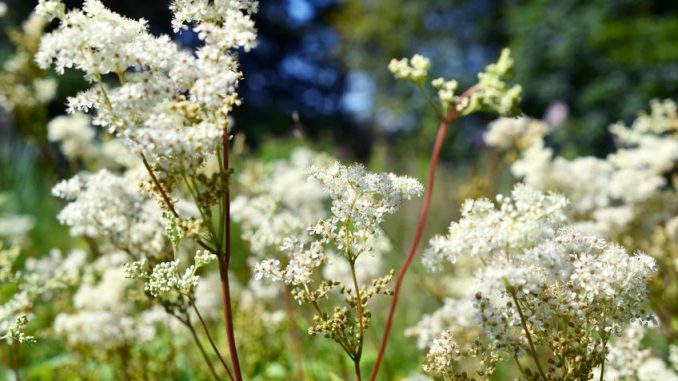
Meadowsweet is also named as Bridewort, Meadsweet, Dolloff, Meadow-Wort, Meadow Queen, Queen of the Meadow, Lady of the Meadow, Pride of the Meadow, Bridewort and Meadsweet. The species name is Spireaea ulmaria or Filipendula ulmaria.
Growth Conditions
Its habitats include streams, marshes, wet deciduous woodland, riverside, swamps, damp meadows, railway banks, ditches, montane herb and damp roadsides. The herb belongs to the family Rosaceae. The term Filipendula is derived from two words: filum and pendulus that means hanging. Meadowsweet is native to West Asia and Europe. It is later introduced and cultivated in North America.
However, it can sometimes persist and grow on north facing chalk grasslands which are often dry. It flowers from May to August. The plant has red marbled and erect stem with 3-9 pairs of toothed, dark green and dentate leaves. Leaves have large terminal leaflets which are 3-5 lobed and about 1-3 inches long. The aromatic flowers have creamy yellow to white petals and used as an ornamental plant. Flower measures 5 mm long and has aroma similar to wintergreen oil. Flowers have five petals and five sepals with 7-20 stamens. Flowers have strong sweet smell. The entire herb possesses a pleasant flavor and taste.
The chemical constituent of Meadowsweet includes flavone glycosides, salicylic acid, tannins and essential oils. Volatile oil contains phenolic glycosides (such as monotropin, spiraein and gaultherin), tannins, flavonoids, mucilage, sugar and vitamin C.
History
Meadowsweet is known by other names and it is known as Meadwort in Chaucer’s The Knight’s Tale and was used as an ingredient in a drink named save. It was strewn in churches for weddings and festivals so known as Bridewort and also made into bridal garlands. In Europe, it was named queen of meadow as it can monopolize low lying and damp meadow.
The term ulmaria means elmlike mentioning an individual leaves that resemble elm. The plant has salicylic acid which is used as a painkiller. The word Filipendula was derived from filum meaning thread and pendulus meaning hanging.
Botanist John Gerard in 1597 acclaimed that the smell delighteth senses. Nicholas Culpeper, an English physician noted therapeutic effects on stomach. In Europe, the plant was called spiraea and in Holland, it is called filipendula. At the time of middle Ages, it was called meadwort as it was used to flavor mead which is an alcoholic drink prepared by fermenting honey and fruit juices. Salicylic acid was isolated from plant in 1838. It was used to make aspirin in 1890s.
Plant
Stems grow from 3-7 ft (1-2 m) high, are reddish to purple, erect and furrowed. Leaves have whitish and downy underneath and dark green on upper side. Leaves are interruptedly pinnate and have large serrate leaflets. It has large terminal leaflets which are three to five lobed measuring 4-8 cm. The plant possess creamy to white flowers which are clustered together in irregular branched cymes with strong and sweet smell. Flowering occurs from early summer to early autumn. Fruit is an achene which is intertwined, alternate and measures approximately 0.12 inch (3 mm) long. It grows on damp and loamy ground. It could be found on shore side meadows, bog margins, damp broad leaved forests and seashore hedgerows.
Flower
Radial flowers form in terminal compound. Cymes are loose arranged with irregular and erect branches. Sepals are up to 5 or 6, pointed, triangular and 1 mm long. Petals are narrowed to short stem, obviate, color ranges to yellowish white about 2-5 mm long. It has glabrous or downy ovaries with flattened stigma bearing style of about 1 mm.
Stem and Leaves
The plant has erect, simple and branched stem above and woody below. Stems are tomentose and glabrous. The plant has alternate leaves which are long petioled to almost sessile. Leaves are ovate in shape, rounded at base and double serrate to dentate. Leaves are lanceolate to ovate and measures about 4-7 cm long. It has pale undersides and is coarsely toothed and smooth. It has dark green pinna.
Please note this page contains links to our affiliate marketing partner. Please read our affiliate disclosure.
Leave a Reply